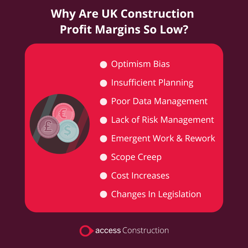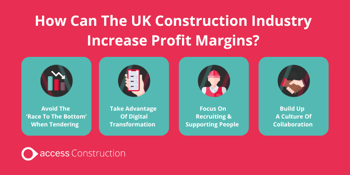What Is An Average Construction Company Profit Margin? & How To Increase Profit Margins In Construction
Profit margins are notoriously low in the UK construction industry, with a 2019 study in the Journal of Building Engineering stating that 44% of construction projects end at a loss. This impacts companies at every tier in the sector, with a ‘race to the bottom’ culture in tendering leading to many companies struggling to turn a profit.
Access Construction spoke to Roy Hedger, Director of the Association of Cost Engineers (ACostE) about the many reasons for project over-spend and offers advice on how to tackle challenges in construction.
What Is The Average Profit Margin In UK Construction?
A 2021 study by consultant Turner & Townsend found that the UK construction sector had the lowest margins in the world at just 3.9% average, compared to 4.6% in North America and 6.1% in Continental; Europe. Continental Europe stood at 6.1 per cent.
Another 2019 analysis by Construction News uncovered that the top 100 firms in the UK had an average profit margin of 2.6%, with the top 10 UK contractors running at an average loss of -0.1%.
Profit margins in the construction industry have been steadily decreasing over the past decade, exacerbated by challenging market conditions including Brexit, the War in Ukraine, recovery from Covid and inflation all contributing to rocketing materials prices and loss of profit in the sector.

Why Are Construction Profit Margins So Low?
We spoke to Roy Hedger, Director of the Association of Cost Engineers (ACostE) over the profit crisis within the sector. Roy outlined the key issues leading to project over-spend and delays.
- Optimism Bias
- Insufficient Planning
- Poor Basic Data
- Risk Management
- Emergent Work and Rework
- Scope Creep
- Cost Increases
- Changes In Legislation
Optimism Bias
“Unrealistic project schedule completion dates or component costs. Insufficient scope and/or requirements definition, which leads to too many assumptions having to be made by the estimator.”
Essentially, construction project managers need to be more realistic when it comes to deadlines and resources. The current significant skills gap in UK construction means skilled workers are in demand.
A recent example of a project which has fallen to optimism bias is the HS2 rail project in the UK, which is facing years-long delays and huge overspend issues – which has resulted in a significant decrease in the scope of the project.
Insufficient Planning
“A lack of pre-project planning and development in the early stages of the project lifecycle leads to unforeseen design development and growth.”
Planning and pre-construction is the most vital part of any construction project, and not spending enough time on cost estimating, procurement and scheduling will lead to blocks and delays later on in the project – which eats into profit.
Poor Basic Data
“May include, for example, gaps in key data, out-of-date data not recognised, data not normalised.”
The construction industry is one of the least digitalised in the UK. Where other industries embrace digital transformation, construction’s reliance on ‘Industry 3.0’ tools such as Excel spreadsheets leads to poor data, poor communication and poor collaboration.
The result? Delays, overspend and a loss of profits.
Roy Hedger recommends construction companies think long-term when it comes to generating profits and investing in collaborative software such as a construction ERP.
“Having a digital platform, accessible to all stakeholders throughout a project lifecycle, has been game- changing as far as this is concerned. A single repository for process and procedures, cost information, risk information, drawings, specifications and schedules mean all parties can access a ‘single source of the truth’ and provide visibility to clients at every stage of the project.
Digital technology has greatly assisted with information flowing freely between all stages of a project lifecycle, from strategic definition, into design stages, manufacture and construction, and into handover and beneficial use. The mantra is ‘info in once used many times’ – the closer we can get to that the better, and the better we get at extracting the out-turns from this environment in a seamless manner the more effective the estimates will be.”
Read our framework for data transparency in construction >
Risk Management
“Failure to recognise project risks.”
Alongside the issue of optimism bias, the industry can also lack the foresight to assess projects for risks. While some risks, such as the catastrophe of the Covid crisis, simply cannot be predicted, other risks can be foreseen using high-quality data and collaborative software to provide that all-important single source of truth.
One of the advantages of digitalisation is technology’s power of spotting patterns and outliers, such as huge price increases, major availability gaps and inaccurate estimates.
Roy Hedger further explained the importance of visibility of data, especially costs, to help mitigate risks and please stakeholders.
“Clients do not like surprises, particularly in open book or reimbursable contract arrangements. Visibility is very important throughout the supply chain because all parties need to be able to quickly and robustly share their cost forecasts and data with the client to keep them fully informed at all stages in the project.
Risk identification and mitigation throughout the supply chain is also key to better decision-making and successful mitigation of these risks Materials traceability is essential on any project. All parties need to be assured that the materials they are buying meet all relevant legislation and project specifications, and that every component that makes up a product, possibly from numerous suppliers, meets all of these requirements. In other words, there are no weak links.”
Emergent Work and Rework
“Necessary works that were not factored into the tender. This tends to happen when a vessel is opened, or the ground is dug up and conditions are not as expected. As the project lifecycle moves on, certain elements of the design are changed or firmed up, altered, or added.”
Rework is such a core issue in construction that an estimated 30% of all work done on construction projects can be classified as rework. While some rework is simply unavoidable, much of it can be avoided through ensuring excellent collaboration in construction to avoid miscommunications, and once again spending more time on the pre-construction phase of a project.
Scope Creep
“A client might add extra work to the project, which in some cases is not captured by the project team as a change and therefore no payment is made for the works.”
Project managers in every industry are well aware of the dangers of ‘scope creep’, where a client may push a project beyond its original parameters. With costs so high and profit so low in construction, scope creep can quickly translate to a loss.
While scope creep can at times be unavoidable, as with risk assessment, it is well-worth investing in experienced construction project managers and estimators who can apply their experience in the sector to spotting and fighting scope creep near the beginning of a project.
Cost Increases (Labour, Plant, and Materials)
“All of these can increase above the estimated escalation factors for a given period.”
Costs of building materials have rocketed over the past few years, with an average price rise of 4.7% in April 2023 alone. Budgets have struggled to catch-up, with project overspend blighting more projects than ever since the economic shock of the Coronavirus pandemic. While recovery will come, it is vital for construction to take price shocks into account during the estimating and pre-construction stage to protect profits.
Using advanced construction estimating software can help estimators draw-up bills of quantities quickly while easily accessing the most recent prices listed by suppliers using extensive price libraries.
Labour prices have also increased in response to the construction skills gap, and need to be accounted for in the estimating and pre-construction phase.
Changes in Legislation
“Leading to a change in how the plant will be operated (a client risk/cost) or how the facility is constructed and tested (a contractor’s risk/cost).”
While legislation can move slowly, changes that happen in the middle of a project can impact on profits. In 2023 alone, changes have been made to both how the community infrastructure levy is calculated and requirements for companies to produce whole life carbon assessments for new developments have been introduced – both impacting on profit margins.
Make Your Data Work For You With Construction ERP
Our industry-leading Construction ERP, Access Coins, gives your business a ‘single source of the truth’ to empower your team and increase your profit margins.

How To Increase Construction Profit Margins?
There are some key actions a construction business can do to help protect and boost profit margins.
- Avoid The ‘Race To The Bottom’ When Tendering
- Take Advantage of Digital Transformation
- Focus On People
- Build A Culture of Collaboration
Avoid The ‘Race To The Bottom’ When Tendering
The so-called ‘commoditisation trap’ has led to a ‘race to the bottom’ culture in UK construction, with contractors sending in the lowest price possible while not taking risks, price rises, rework and scope creep into consideration. While it is tempting to try and win projects with low prices, this results in rock-bottom profit margins and losses across the sector.
It helps to sell-in your specialisms, expertise and professionalism while tendering your projects – while you may not be putting in the lowest price, quality and good relationships count for a lot. It also pays to be picky with projects – if a project is making it clear they will go for the lowest price, then it is worth not investing the time and money into tendering and moving onto the next opportunity. This will lead to healthy profits in the long-term.
Roy Hedger, Director of the Association of Cost Engineers (ACostE) shared his thoughts on avoiding the race to the bottom:
“Rather than discounting rates and prices, companies need to invest some time in researching working practices which enable them to work quicker and smarter, while delivering a higher quality product.
If they can work quicker and more efficiently than their competitors, they can afford to price the works without discounting rates as the time spent will be less, therefore offsetting the increased rates. Where they cannot work more efficiently, then estimators could suggest a higher-performing product for clients looking to make savings over the lifecycle of their asset. If a client spends a little more now at the construction stage, they might then see longer term benefits of lower running costs. Of course, it can be a riskier strategy too given that most clients only think about their bottom-line capital costs.”
Take Advantage of Digital Transformation
The advantages of getting ahead in your construction digital transformation journey are innumerable. A Construction ERP will help you with budgeting and forecasting to control costs, project management and your procurement process. Having all of your data in a single connected system also helps with risk management, calculating costs, encourages collaboration and shares a single version of the truth within your team, avoid the miscommunications which can lead to rework. Technology also helps cut out hundreds of hours of manual administration work across a project through automation – leaving teams with more time to focus on vital, growth-focused activity.
Construction is still behind when it comes to making the most out of ‘Industry 4.0’, the new wave of technology which includes cloud computing, AI, and big data. All of these useful tools help with planning, productivity and, above all, profit.
Focus On People
The UK construction skills gap of over 200,000 workers means that the ones you have in your company are some of the most vital resources you have. Recruitment, training and retainment can quickly cut into budgets on every level – from the back office to on-site workers.
It is worth investing in health and safety training and focusing on building a positive culture within your company to ensure your most important asset remains with you and keep up the high productivity levels required in construction.
Build A Culture of Collaboration
Having a team singing from the same hymn sheet and accessing the same information, especially in the planning and preconstruction phase, will lead to a project running smoothly through to the successful (and profitable!) end-point.
Introducing consistent project management processes and having your entire team working on the same tools will help with the collaboration which is so vital for protecting your profit margins.
Building this can take time, but if you are thinking of improving your profit margins in the long-term, it is well worth investing time and money into giving your team the tools and expertise to work collaboratively.
Read more about building a culture of collaboration in your construction company. >
Transform your processes and protect your profit margins with Access Coins ERP.
More construction software information, guidance and advice

What Is Cost Value Reconciliation (CVR) In Construction?
Go to article
What Is Job Costing In Construction?
Go to article
Benefits of Using ERP In The Construction Industry – Reviewing The Pros and Cons Of An ERP System
Go to article
